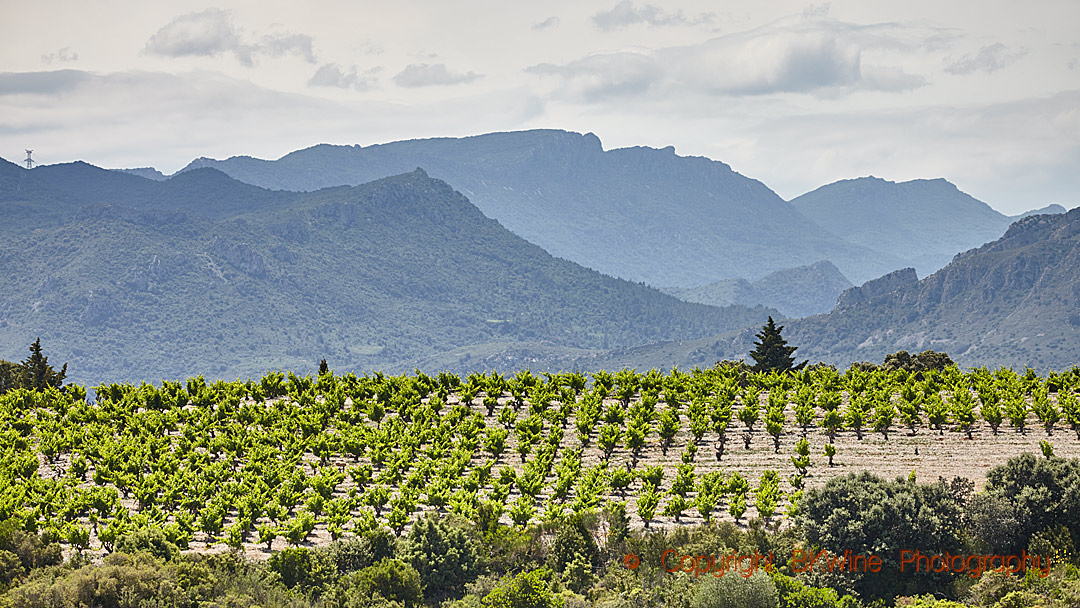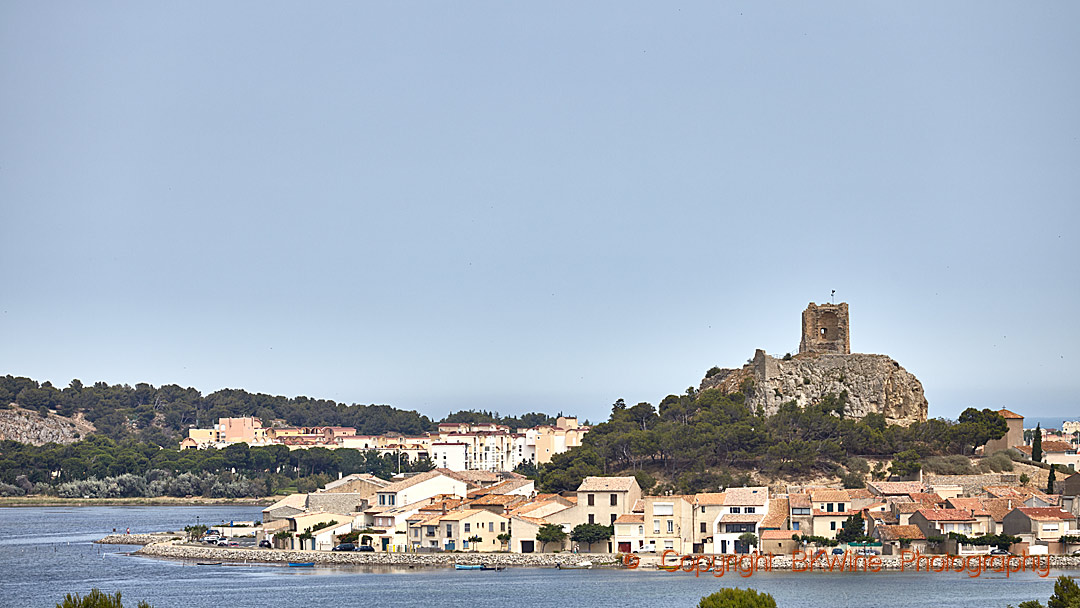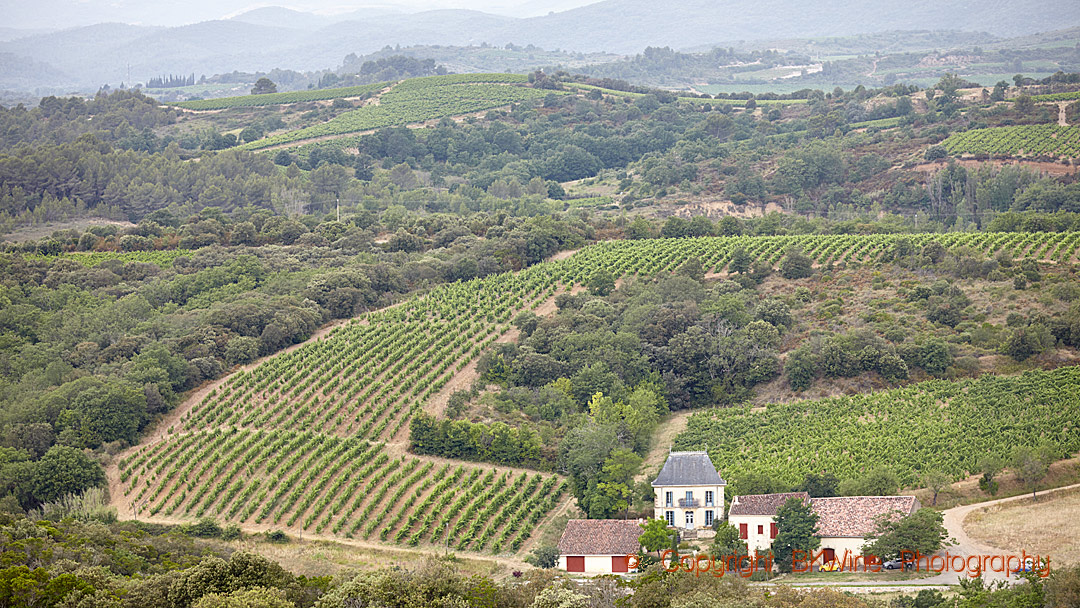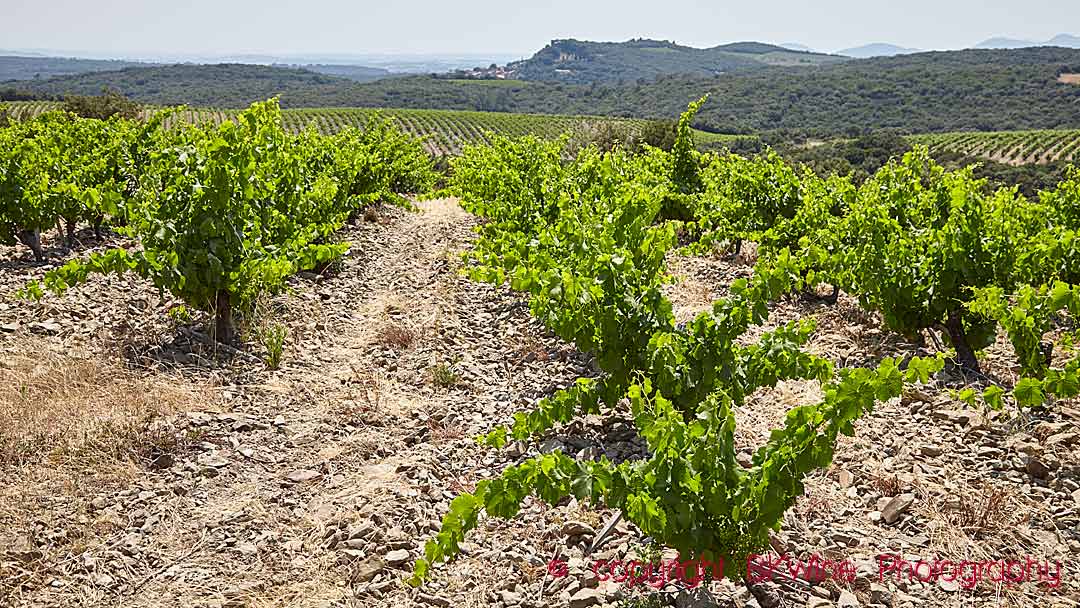Languedoc in southern France has become a dynamic and exciting wine region. The region has an incredible variety of wines, including red, rosé, white, and sparkling. The warm climate produces wines with generous fruit but without excesses. A fresh acidity is often present. Languedoc brings us quality at every level, from unpretentious but well-made wines to high-quality ones with bold price tags. But like many other wine regions, Languedoc must prepare for challenging times.
Languedoc is beautiful and, in places, wild and desolate. It is France’s largest wine region, with 220,000 hectares. There are extensive contiguous vineyards on the plains, but many are located towards the mountains, where the vineyards are interspersed with the typical and fragrant vegetation known as garrigue. There is an enormous plant diversity. The wine producers do not have to plant trees and bushes; they are already there. Languedoc accounts for almost 30% of France’s wine production, so it is no wonder the wines are visible, both at home and on the export market.
This is a longer version of an article published on Forbes.com.
Languedoc quick facts:
- Location: South of France, on the Mediterranean coast, between Roussillon and the Rhône
- 220,000 hectares of vineyards
- IGP (previously vin de pays) 50%, AOC/AOP 36%, vin de France (previously vin de table) 14% (2014)
- Grapes : a wide variety of grapes. For reds: syrah, grenache, carignan, mourvèdre, cinsault, merlot and many others. For whites: grenache blanc and gris, clairette, macabeu, clairette, piquepoul blanc and noir, terret, marsanne, roussanne, vermentino (rolle), chardonnay, chenin blanc, and many others.
- Soil: very varied, including much limestone, schist, sand as well as volcanic (basalt and other)
- Climate: very varied depending on location but generally quite warm Mediterranean, cooler inland in the mountains
- Appellations: numerous. Some of the main ones: La Clape, Pic Saint Loup, Faugères, Saint Chinian, Minervois, (Minervois) La Livinière, Fitou, Corbières, Picpoul de Pinet, Limoux, Terrasses de Larzac etc
Languedoc, situated along the western part of the Mediterranean Sea, is the birthplace of the French wine industry, the cradle of French wines. For over 2,000 years, wine has been a vital part of the region’s economy. The warm and sunny climate of Languedoc made it easy to produce large volumes of simple wine, and during the large part of the 20th century, bulk wines dominated, simple everyday wines that were in high demand, at least some of the time.
When wine consumption in France began to fall in the 1970s, overproduction was a fact. This led to “great lake of wine” and that was not empty until around 2010. One way to solve the problem was to grub up vineyards. Since 1975, the region has lost over 40% of its vineyard area. Another important change is the grapes that are grown, from high-yielding low-quality grapes to ones that give better wines. Today, the region is in balance. The self-confidence among its producers is at its peak, just like the quality of the wines.
The Languedoc appellations and sub-regions
Today, the “table wines”, the lowest echelon on the French wine hierarchy, account for a tiny part of the production. These wines were previously categorised as “vin de table”, up until 2009, and are now called “vin de france”. This name change has arrived together with a serious increase in ambition for some of the wines in this category.
Today, the table wines (previously vin de table, since 2009 renamed vin de france) account for a very small part of the production.
The IGP wines, the next level up in the hierarchy, dominate with around 65% of the production. These wines were previously called “vin de pays”, a denomination that may still be more familiar to many people. The largest of them all is the IGP Pays d’Oc which accounts for 65% of all IGP wines in all of France.
Most IGPs are unpretentious and fairly inexpensive wines. They are well made but usually don’t have much personality. But there are very many exceptions, IGP wines with very serious ambitions. The wines have been a great success on the export market. This applies not least to the wines called vin de cépage, where the grape is indicated on the label. These wines appeal to many consumers who prefer to choose wine by grape.
Since the bulk wine era, the number of appellations has increased explosively. There were only a few AOCs before the 1980s. But as production decreased, the quality increased. Both growers and consumers began to care about the origin. More and more districts, large and small, wanted (and still want) to get the recognition and the status for their specific location that an AOC gives them. The feeling that an origin provides an identity to the wine has become strong in Languedoc. Today, there are roughly 20 appellations: Faugères, Saint Chinian, Picpoul de Pinet, Terrasses de Larzac, La Livinière, La Clape, and Limoux, to mention but a few.
There is one “umbrella” appellation called AOP Languedoc. It is a large regional appellation that was created in 2007 and then replaced the old Coteaux du Languedoc.
The appellations produce around 30% of the wines in Languedoc. Most AOCs are now AOP (appellation d’origine protégée) which means they are a protected origin at EU level. The two labels, AOC and AOP, are used interchangeably.
Lovely but sometimes challenging climate
Languedoc is a wine region larger than all New World countries except the United States. Various soil types, climatic conditions, and grape varieties exist here. Because it is so big, it is hard to find one characteristic that is particularly typical of the Languedoc. The sun, the winds, the sea, and the mountains affect the wines to varying degrees. If one would try and describe them as a group it could be wines with plenty of fruit and spices with a southern warmth and intensity. But there are, here again, many exceptions and variations.
Although many vineyards are situated towards the mountains, the Mediterranean Sea is never far away and this influences many wines. The southern Mediterranean winds are mild and humid. But there are also northerly winds such as the mistral and tramontane. These winds are perfect for drying the vineyards after the rain, which the growers are grateful for as it reduces the risk of fungal diseases. Thanks to this clement climate 20% of the Languedoc vineyards are organic. The winds can be strong, and we see a lot of bush vines, or gobelet, as this kind of pruning is well adapted to the winds (and drought). Toward the mountains, at a slightly higher altitude, the landscape and temperature change. It gets cooler, not least at night.
Languedoc has many hours of sunshine and can get hot in the summer. Slopes with northern exposure are appreciated more and more, where the grapes are less exposed to the sometimes scorching sun. It is also dry. It usually rains enough, and although rain has always been rare in the summer, the vines have adapted and survived even long periods without rain. But these periods are now getting longer and longer. The latest few years have been difficult with very sparse rain.
The vine is a fantastic plant that manages well with only a little water. But if not even that tiny amount of water is there, the vines weaken, and the yields are reduced, sometimes drastically. The harvest volume has decreased since the beginning of the 2000s and INRAE (Institut national de recherche pour l’agriculture, l’alimentation et l’environnement), a French research institute, believes that the climate is the main reason. It is not just the volume that suffers. A persistent lack of water during the ripening period can have negative consequences on the chemical composition of the grapes and, thus, on the taste of the wine.
So, it is easy to understand why irrigation is spreading in Languedoc. So far, we see it mainly in the plains and, above all, for the IGP wines. Only around 10% of the area has been affected so far. A project has been ongoing for a few years to ensure irrigation for an additional 20,000 hectares.
The rules of some Languedoc AOC-appellations do still prohibit irrigation so the situation varies. We should perhaps point out that irrigation is generally permitted in all of the EU but that local rules, the rules of the individual appellations, can ban it. Irrigation is becoming more common. But this also raises the issue of access to water; even if it is permitted, if you have no water, you cannot do it and water is becoming increasingly scarce. (Sometimes it is said that irrigation is banned in Europe’s vineyards but that is not the case.)
Technical changes are also planned in the vineyard to prepare the vines for dry weather. The producers are also experimenting with alternative grape varieties that have good resistance to drought. Local grape varieties that have been all but forgotten are now being tried out.
Various soil types add to the diversity
The vines of Languedoc grow in various soil types: light sandy soils, sandstone, schist, large pebbles, limestone, more or less mixed with clay, flint, granite, and basalt. Hardly any of the many appellations have homogeneous soil, though. The big ones have a mosaic of different types.
Faugères is one of the few where one type of soil dominates; it’s vines grow mainly on schist.
Schist is found in parts of several other appellations, such as Saint Chinian and Terrasses du Larzac. Schist is a poor and porous soil, and it is a rock that easily splits into thin flakes. To find water, the vine roots often go through the cracks in the rock.
Limestone is also abundant. La Clape is a limestone massif by the sea, just next to Narbonne. The whole area is a protected nature reserve with beautiful hiking trails. Limestone is found to a greater or lesser extent in many places throughout Languedoc. It is in limestone soils that the garrigue grows best. The garrigue is a type of vegetation typical of the Mediterranean area that we find around the vineyards. Fragrant herbs, wild garlic, lavender, juniper bushes, blackberry thickets and low-growing green oaks grow here. Birds, insects, and small animals live here. Winegrowers – and consumers – often find a taste of garrigue in their wines.
The grapes, both local and imported
Languedoc is, above all, red wine. However, rosé wines have increased dramatically in recent years. The white wines can be amazing. The volume is small, but even the whites are starting to take shares from the red wines.
In the last 40 years, the vineyards of the Languedoc have entirely changed. Not only has the vineyard surface decreased drastically, but the wine producers plant almost completely different grapes today. During Languedoc’s time as a volume producer, aramon and carignan dominated. Both produced huge yields, especially aramon. The wines were low in alcohol and probably didn’t have much flavour.
Aramon has been cultivated in the south of France since the 19th century. Until 1960, there were 150,000 hectares planted in Languedoc and Provence. Today, there are 1,200 hectares, and it continues to decrease. Probably not many people mourn the demise of aramon. On the other hand, I saw the other day an ambitious wine made with 100% aramon and aged in amphora (I haven’t tasted it, though). Who knows, aramon is maybe on its way to make a comeback?
The most important southern grape found throughout the Mediterranean region, including Spain, is grenache (garnacha). It has been around for a long time in Languedoc (and Roussillon) and has always had a good reputation here. It thrives in the heat and ripens with high alcohol levels, which could possibly become a problem in the future.
Carignan is still much planted but has dropped to fourth place. However, unlike aramon, carignan has been fundamentally re-evaluated by wine producers. It handles the heat and the powerful winds in the south of France well. If treated correctly, carignan can produce superb wines with character. We see many examples of that today.
Cinsault is an old Languedoc grape that is also experiencing a renaissance. The grape produces elegant wines in a light and very drinkable style.
The grape that is the most cultivated variety today in Languedoc is syrah, which occupies 15% of the vineyard surface, closely followed by grenache (13%), merlot (12%), carignan (10%), cabernet sauvignon (7%), cinsault (5%) and mourvèdre and marselan (each 2%).
- syrah, 15%
- grenache, 13%
- merlot, 12%
- carignan 10%
- cabernet sauvignon 7%
- cinsault, 5%
- mourvèdre, 2%
- marselan, 2%
The Languedoc producers started planting syrah and mourvèdre in the 1970s. They were introduced because they were said to improve the quality of the wines, so called cépages améliorateurs. Many Languedoc producers believe Syrah is indispensable today. A pity, perhaps. Syrah undoubtedly adds colour and tannins to grenache but can sometimes become too dominant.
The most planted white grape varieties are chardonnay, sauvignon blanc, muscat à petit grains, grenache blanc and viognier. Other interesting ones are grenache gris, macabeu, terret, roussanne, clairette, bourboulenc…
For appellation wines, the rules of each AOP strictly regulates which grapes can be used and even in what proportions. For most red AOC wines the permitted grapes are syrah, grenache, carignan, cinsault, mourvèdre and lledoner pelut (a close relative — a mutation — of grenache noir also called grenache poilu, “hairy grenache”). All appellation wines must be blends of at least two grape varieties. Certain grapes, usually syrah, grenache and mourvèdre, are main grapes and must dominate the blend. The rest, such as carignan, are accessories and may only be used to a limited extent. Sometimes, however, carignan is considered hugely suitable to certain local conditions and is upgraded to a main grape. This is the case in Fitou and Corbières.
When the vin de pays wines (now IGP) became popular in the 1990s, grape varieties with no connection to the south of France began to appear: merlot, cabernet sauvignon, sauvignon blanc and more. Languedoc’s vineyards are a mosaic of different grape varieties today. If you make IGP wines, you can choose between about 50 grape varieties.
Within the IGP category there are many ambitious wines. Many growers make wine in both categories, AOP and IGP. Maybe they want to use a grape that is not allowed in the appellation wine. Or perhaps they want to make a single-variety wine, which is generally neither allowed for the reds in the AOC/AOPs but can be done as IGP. Sometimes creative and innovative winemakers feel that their wines do not fit into the appellation framework.
Today, more and more grape varieties are appearing. There are several drivers for this, a general desire for experimentation, of course, but also worries about climate change (heat and drought) and a quest for more disease resistant varieties. For example, two crossings made in the 1960s are being more and more used: marselan, a cross between grenache and cabernet sauvignon, and caladoc, a cross between grenache and malbec. Local grapes such as piquepoul noir, counoise, rivairenc, terret noir and morrastel (graciano in Spain) are slowly starting to be used in certain appellation wines, albeit with strict limits.
Languedoc-Roussillon wines today are about character, personality, and excellent quality. It takes time to shake off a bad reputation. But in the last 10–15 years, things have turned around dramatically. Consumers associate Languedoc more and more with affordable, pleasant wines, even world-class quality. And the wine lover knows that this is where you find exciting and slightly unusual wines. Just the way we like it.
Forthcoming articles in our new Languedoc series will cover white wines and some of Languedoc’s exciting appellations.
Here’s the cover of our (second) book on the wines of the Languedoc:
































